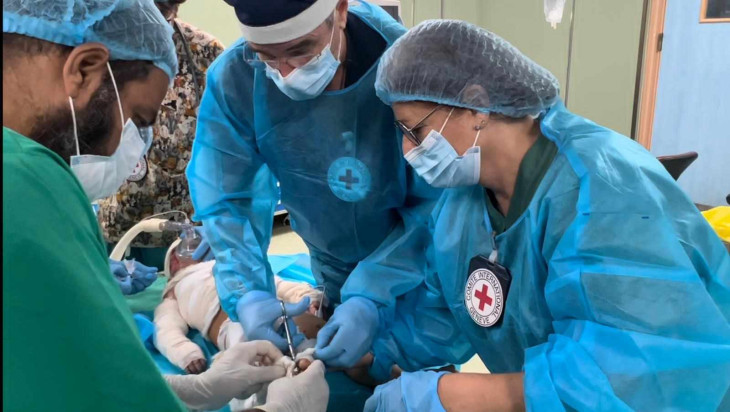Building on its strong mandate and longstanding presence, and initially drawing on its built-in emergency capacity, the International Committee of the Red Cross (ICRC) swiftly adjusted and scaled up its response to address new needs in Israel and Gaza. It also stepped up its response in the West Bank to address the humanitarian consequences of an acute rise in violence further exacerbating people’s ability to cope with the impact of longstanding occupation policies.
The ICRC works in close coordination with its partners in the International Red Cross and Red Crescent Movement, in particular, the Palestine Red Crescent Society (PRCS) and Magen David Adom (MDA) and continues to work closely with local service providers and communities on the ground.
Below is a summary of our response so far, including programs addressing ongoing and emerging needs throughout the region:
Dialogue on Respect for International Humanitarian Law and Protection of Civilians
- Engaged the parties to the armed conflict to remind them of their obligations under International Humanitarian Law (IHL), and in particular on of the rules governing the conduct of hostilities, the protection of civilians and civilian infrastructure, the prohibition of hostage-taking, the protection of the medical mission, the civilian population’s access to essential services and the treatment of persons arrested and detained.
- Monitored respect for IHL throughout Israel and the occupied territories, raising concerns with the parties to the conflict and providing concrete recommendations to prevent IHL violations and minimize human suffering, as part of our continuous bilateral and confidential dialogue.
- Made daily real-time interventions aimed at ensuring better protection of civilians and the medical mission.
- Fostered increased understanding and support for IHL and for principled humanitarian action with national and international stakeholders and actors of influence.
Working to bring families together
- Facilitated the release, transfer and return of 109 hostages from Gaza to their families.
- Facilitated the release, transfer and return of 154 Palestinian detainees from Israeli places of detention to their families.
- Received 4,059 requests from family members seeking to clarify the fate and whereabouts of their loved ones through existing channels and additional emergency hotlines in Arabic, Hebrew, and English. So far, 606 cases have been closed as family contact has been re-established.
- Engaged with families of missing persons to collect relevant information and explain the nature and modalities of our work.
Ensuring dignified treatment of human remains
- Distributed 11,164 forensic items to facilitate the dignified management, identification and eventual return of human remains to their families. 1,200 items, including face masks, face shields and personal belonging bags were distributed in Israel. Over 9,800 items, including face shields and body bags, were distributed in Gaza.
- Provided technical support and established a partnership with Israel’s National Center of Forensic Medicine to strengthen their capacity for the management of complex cases of the missing in armed conflict.
- Started work to assess and strengthen local capacity in Israel and Gaza to enable the identification, recovery and return of human remains to their families.
Monitoring treatment and conditions of detention
- Continued to call on relevant Israeli authorities to resume the ICRC’s detention visits, and its Family Visit Program for Palestinian detainees held in Israeli places of detention.
- Continued to call for the release of hostages held in Gaza, for their humane treatment, access to adequate health care, ability to re-establish contact with their families, and for the ICRC to have access to them.
- Visited 219 people in 12 places of detention in the occupied Palestinian territory, including one in Gaza and 11 in the West Bank, to assess and monitor their treatment and conditions of detention. The ICRC’s assistance helped improve conditions of detention for 12 detainees.
Supporting vulnerable people in meeting basic needs and sustaining livelihoods
- Up to 50,000 vulnerableindividuals (or 10,000 vulnerable households) in Gaza, mostly persons internally displaced by the ongoing hostilities, received cash assistance of 750 ILS/household) to cover basic needs for one month.
- 38,180internally displaced persons (or 7,339 households) accommodated in non-UN shelters in Gaza, Khan Younis and the Middle Area received essential household items, including blankets, jerrycans, tarpaulins and hygiene parcels.
- 2,000 pregnant and lactating mothers in Al-Shifa Hospital in Gaza received high nutritional food bars.
- In the West Bank, 185 vulnerable individuals(or 37 vulnerable households) received cash grants to support livestock production, 14 diploma students received vocational training at the Polytechnic University in Hebron, and 22 vulnerable households received cash support to help them recover from the consequences of specific incidents of violence in the West Bank.
- 76 families whose houses were demolished in various locations in the West Bank, including East Jerusalem, received cash assistance to help meet their immediate needs.
Delivering or enabling emergency medical response
- Provided medical supplies, including weapon-wounded kits, wound dressing sets, medicine, and emergency medical sets, to eight local health facilities, enabling around 19,000 individuals to receive emergency medical care in Gaza.
- Deployed two surgical teams in Gaza, specialising in the clinical management of the weapon-wounded and providing a comprehensive package of care.
- Working from the European Gaza Hospital (EGH) since 1 November 2023, these surgical teams performed 498 surgical procedures, of which, around 50% were general surgical interventions, 26.5% were reconstructive surgery, and 23.5% were orthopaedic surgery. 110 patients received other immediate medical attention or follow-up, and the team applied 686 burns dressings.
- Conducted 486 sessions to provide patients, families, and/or caregivers in the EGH with basic emergency mental health care and psychosocial support.
- Provided 540 physiotherapy sessions to patients at the EGH.
- Provided technical and financial support to the Israel Trauma Coalition to support the delivery of stress management training to frontline health workers.
- Delivered an online training course to support the Association of Rape Crisis Centres in Israel to organize technical workshops for their staff on providing mental health and psychosocial support for victims of sexual violence in armed conflict.
- Made 117 real-time interventions to facilitate access and safe passage for PRCS ambulances to provide medical care to people injured because of the violence in the West Bank.
- Provided two negative pressure wound healing machines to Jenin Hospital in the West Bank.
- Provided around 300 wheelchairs to the Patient’s Friends Society (Abu Raya Rehabilitation Center) in Ramallah.
- Provided over 1,000 litres of IV fluids to emergency health facilities in the West Bank.

Delivering or enabling access to clean water and power:
- Helped 285,000 people in and around Gaza City, Beit Lahia, Khan Younis, and Rafah regain access to clean water by supporting local service providers to provide water, carry out network repairs, and power water wells and desalination plants in Gaza.
- Supported 20,000 internally displaced persons in accessing clean water in 12 shelters in Gaza by carrying out emergency repairs of desalination units and sanitation infrastructure and installing solar-powered water treatment units.
- Equipped three structures of the local electricity supplier in Gaza (GEDCo) with solar systems to ensure minimum operational continuity of services. Also, we provided financial support and supplies from the ICRC’s contingency stocks to enable GEDCo to carry out emergency repairs to the power network, protect critical infrastructure, and prepare for rehabilitation as soon as security conditions allow.
- Supported emergency power supply and fuel rationing for 14 hospitals across Gaza through existing ICRC projects for the maintenance, optimization and resilience of the public health sector’s generator fleet
- Assisted 5,000 people in the H2 area in Hebron to have access to enhanced wastewater and drainage systems by providing technical and material support to Hebron Municipality in the West Bank.
- Supported the Palestinian Water Authority in the West Bank to enable 6,000 people in Qariout village and 13,000 people in Burin village to have improved access to water.
- Provided technical and material support to Ein Al-Beida Village Council in the Jordan Valley to enhance access to electricity for 1,750 farmers in the area.
- Supported 50 households in the H2 area in Hebron with solar panels to enhance their access to electricity.
Preventing risks from weapon contamination
Together with the PRCS, the ICRC helped raise awareness among civilians as well as humanitarian, medical, and other frontline workers in Gaza on the risks of weapon contamination and explosive remnants of war:
- Distributed awareness messages through SMS to 400,000 phone numbers.
- Promoted safer behaviour through posters and group sessions for reachable affected populations in hospitals, schools and shelters.
Engaging with affected people
- Received requests from 37,257 people in Gaza, the West Bank and Israel raising protection concerns for ICRC follow-up.
- Established three hotlines –in Arabic, Hebrew, and English– dedicated for people looking to re-establish contact with, or ascertain the fate and whereabouts of, their family members.
- Reinforced the ICRC’s existing Community Contact Center (CCC) in Gaza and established two additional centers to serve people affected by the conflict and violence in Israel and the West Bank.
- Answered 14,152 calls from people in Gaza, Israel and the West Bank, who raised concerns about losing contact with loved ones, sought support to evacuate injured people or people trapped in the hostilities, or requested assistance (e.g., food, non-food, water, electricity).
- Continued working closely with local communities and service providers to involve them in the ICRC’s needs assessments and its programme design, delivery and evaluation.
Strengthening the Resilience of Essential Services in Gaza to Respond to Humanitarian Consequences of Hostilities
The ICRC strives to ensure that critical and essential service systems in Gaza can continue to operate and serve the civilian population during hostilities by building an operational resilience approach into ongoing ICRC programs, with the overall aim of enabling essential services as well as communities to cope better and for longer during hostilities.
Many of the foundations, for that end, were laid before the current hostilities broke out, including:
- The upgrading and rehabilitation of the Emergency Department at Al-Shifa Hospital, the main referral hospital during hostilities in Gaza City, which increased its capacity to treat the huge influx of injured people.
- The installation of dedicated powerlines, adds flexibility to the electric network operator and allows a prioritized delivery of electricity to key services and critical health, water and wastewater facilities during escalations.
- The installation of remote-controlled electrical switches on the network, increases the control of electricity service providers, providing redundancy to the network, and minimizing outages caused by damage common during escalations.
- The installation of remote monitoring and control systems in water and wastewater facilities decreases the need to expose maintenance staff to dangerous field operations, and enables a faster understanding of specific damages, thereby decreasing disruptions of the system.
- The supply and maintenance of heavy equipment vehicles, improving the efficiency of water service provider’s employees when repairing damages made to water and wastewater network.
- The distribution of ecological traps (bio-traps) to farmers as a cost-effective and low-maintenance alternative to chemical pesticides, ensuring ongoing protection of trees against pests, even when escalations endanger or restrict movement and farmers are unable to visit their crops for a long time.
We acknowledge Source link for the information.



